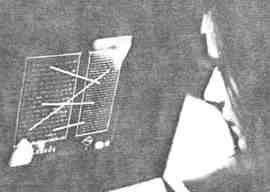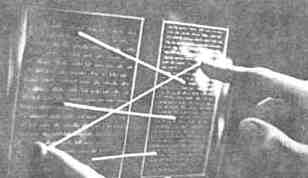parexamples .html
98.11.29 ( d15
To Ted Nelson Home
Page
Examples of Parallel Documents 
Back to "My Parallel Universe"
Back to "Documents are Parallel
by Nature"
Documents are intrinsically parallel. Sound too complicated?
Sorry. It's always this way. That's the nature of information--
it comes in packages which supplement and disagree.
Example: The Bible.
The "book" that is called The Bible actually exists in many parallel
versions. The Old Testament is basically the Hebrew Torah (of which
an earlier, shorter version has recently been discovered in Ethiopia).
The New Testament is a series of writings in Greek. Then there are
the various translations of both Old and New Testament, either affected
by culture and politics, or (some may say) guided by Divine Protection
into perfect representations of the Word of God. Yet there are so
many differing translations: for example, the English translations known
as the King James Version (Episcopalian/Church of England), the Douay (Catholic)
version, and various Twentieth Century versions. Then there are the
translations into all other languages-- with differences in meaning that
no one can know.
All of these, taken together, are "The Bible."
In addition, there are the Coptic Bible, the Greek Orthodox Bible, the
Islamic Koran (said to be a parallel version), the Book of Mormon, and
various books referred to as "Apocrypha", all of which have legitimate
claim to be considered as versions of "The Bible". (A large work
called The Interpreter's Bible collates some of these parallel materials.)
Would you like things to be simpler? So would a lot of people.
Many people would prefer that you have access to only one version-- theirs.
This is also the nature of information.
Example: "Rasho-Mon"
The Japanese novel and Kurosawa film "Rasho-Mon" (-- note to my English-speaking
readers: you have to pronounce it with the emphasis on the first O, or
they won't know in Japan what you're talking about--) is the same story
told six times by six different characters, including a ghost.
Which story is "true"? No one knows. But the the movie is
about the parallel structure of all the stories together.
Example: "Hamlet".
We think of Shakespeare's plays as being unique objects. However,
Shakespeare's plays have come down to us in various versions, several of
which are by Shakespeare, and many of which have been severely modified.
"Hamlet" consists of *all* these versions, including also the "Hamlet"
movies starring (respectively) Lawrence Olivier, Richard Burton, Mel Gibson
and Kenneth Branagh.
Example: The Bill of Rights
When Americans refer to "the Bill of Rights", they are ordinarily referring
to the first ten amendments to the U.S. Constitution. But there is
another Bill of Rights from which it derived: the Bill of Rights of the
state of Virginia, written by George Mason.
These two parallel Bills of Rights may be thought of, for many purposes,
as one document.
Example of Commentary: Nabokov's Pale Fire
The novel Pale Fire, by Vladimir Nabokov, consists of two parts:
a beautiful poem of a thousand lines, entitled "Pale Fire", supposedly
by a character named John Shade; and a ridiculous commentary by a character
named Charles Kinbote. The novel is the relation between these two
parallel documents.
Example: VARIANT LISTINGS, e.g. Saints
Often two listings need to be compared. We may think of each
of these listings as a version, and the set of listings as a document.
Example: The Catholic saints, the Episcopalian saints, the Byzantine
saints, the Albigensian saints. These give us overlapping lists of
the official saints recognized by each denomination. (And a time-series
of Catholic saint listings, for example, would show the now-decanonized
St. Christopher and St.Nicholas and when they lost official favor.)
Example: The Three Mile Island transcripts.
My favorite example of parallel documents comes from columnist/man-about-the-Valley
Robert X.Cringeley, whose real name is Mark Stevens. He tells me
this story from his work on the Presidential commission that investigated
the Three Mile Island disaster.
According to Stevens, the Federal disaster management agency (whatever
it was called at that time) first denied having known about the Three Mile
Island nuclear accident, and then revealed that actually they had
had fifty telephone lines into the nuclear plant at the time of the accident--
all fifty conversations being simultaneously recorded. Stevens
says he had the recordings seized under subpoena and then transcribed.
We may consider these fifty recordings and their fifty textual transcriptions
as ONE SINGLE DOCUMENT.
Example: "The Carol Burnett Show" archive
It was recently announced* that 284 episodes of "The Carol Burnett
Show", and all the associated documents (some 350,000 pages) will be donated
to the UCLA library. We may think of this as being 384 parallel documents
(a set for each show-- notes, scripts, and the recorded show itself); or
we may think of the whole collection as a single, fairly
large-scale parallel document.
*(From http://cnn.com/SHOWBIZ/News/9811/18/showbuzz/index.html):
LOS ANGELES (CNN) -- Comedienne Carol Burnett has announced
that all 284 episodes of her "The Carol Burnett Show" will be housed for
posterity at the University of California, Los Angeles. The collection,
which also includes 350,000 pages of music, script notes and commercials,
will be housed at the UCLA Library and in the university's Film and
Television Archive.
"I'm so happy that we can share the many years of music
and sketches from our shows with the students of UCLA and people interested
in the entertainment industry," Burnett said Monday in announcing her donation.
"This is a wonderful way for the material to continue to have a life."
The popular television comedy hour aired on CBS from 1967 to 1978 and won
25 Emmy Awards.

Back to "My Parallel Universe"
Back to "Documents are Parallel
by Nature"